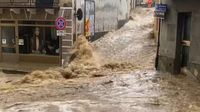On April 17, 2025, the Piedmont region of Italy faced a severe weather crisis as heavy rains led to significant flooding, particularly in the areas of Rubiana, Almese, and Villar Dora. The Messa river overflowed its banks, creating a torrent that inundated streets and residential areas, prompting emergency evacuations and road closures.
The flooding began early in the day as the relentless rain continued to fall, with rainfall accumulations exceeding 200 mm in some areas. This deluge caused the Messa torrent to overflow in both Almese and Avigliana, where emergency services had to evacuate several families from Drubiaglio, a frazione of Avigliana. The mayor of Villar Dora, Norma Tabone, declared a state of emergency, closing all roads within the municipality and rendering the town inaccessible.
In Rubiana, the situation was particularly dire. Footage shared on social media depicted streets transformed into cascading waterfalls as the torrent surged. Local authorities reported that the overflowing river invaded inhabited areas, leading to localized flooding and significant property damage. Rescue operations were quickly mobilized, with the Civil Protection and Fire Brigade working to secure the most affected zones.
As the day progressed, the severity of the situation escalated. According to reports, landslides occurred on provincial roads, isolating Rubiana and complicating rescue efforts. The mayor of Turin, Stefano Lo Russo, acknowledged the critical nature of the weather conditions, emphasizing the need for residents to avoid outdoor activities and limit travel to essential trips only.
In addition to the immediate flooding concerns, the region faced a red alert for hydrogeological risk issued by Arpa Piemonte, warning of potential landslides and further flooding as the rains persisted. The alert extended across several valleys, including the lower Valsusa, Sesia, and Cervo valleys, indicating widespread danger.
The impact of the flooding was felt beyond just the immediate physical damage. Farmers across the affected regions reported devastating losses, with approximately 1,000 hectares of crops destroyed, particularly in Canavese and the Bassa Valle di Susa. The Dora Baltea river also overflowed, flooding over 500 hectares of newly sown maize fields, while farmers in Strambino reported evacuations of livestock due to rising floodwaters. Bruno Mecca Cici, president of Coldiretti Torino, estimated initial crop losses at over 2 million euros, a figure that could triple once recovery costs are factored in.
As the situation unfolded, local authorities remained vigilant, with the Centro Coordinamento Soccorsi (CCS) activated to coordinate emergency responses. By midday, the levels of several rivers, including the Stura and Malone, were reported to be dangerously high, leading to the closure of multiple bridges and roads. Train services between Settimo Torinese and Rivarolo were suspended due to the risk of flooding, with passengers redirected to bus services.
In the city of Turin, the heavy rains caused significant disruptions, including fallen trees and blocked roads. The municipal government was closely monitoring the situation, and emergency services had completed over 160 interventions to assist those affected by the floods.
Images and videos circulating on social media highlighted the extent of the disaster, showing the Messa river and its tributaries wreaking havoc across Almese, Rubiana, and Villar Dora. The visual evidence underscored the urgency of the situation as residents grappled with the aftermath of the sudden and severe flooding.
As the day drew to a close, the weather forecast indicated that the rains would continue, raising concerns about further flooding and landslides. Authorities urged residents to stay informed through official channels and adhere to safety guidelines.
The unfolding crisis in Piedmont serves as a stark reminder of the increasing frequency and intensity of extreme weather events, highlighting the need for robust emergency preparedness and response strategies. As communities begin to assess the damage and plan for recovery, the focus will undoubtedly shift to how best to support those affected and mitigate the risks associated with future weather-related disasters.










